SAM
+ SAM: SIZING UP THE NEIGHBORHOOD ON MARS [Click to Expand]
—IS ANYONE HOME?
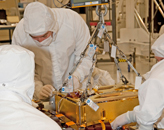 Mars today is a desolate world of cold and windswept deserts, apparently without life of any kind, at least on the surface. But there is evidence of a wetter (and possibly warmer) past—features resembling dry riverbeds and minerals that form in the presence of water indicate that water once flowed through Martian sands. Since liquid water is required for all known forms of life, scientists wonder if life could have risen on Mars; and if it did, what became of it as the Martian environment became more hostile, drying up and losing its magnetic shield, the atmosphere growing thinner, and the climate changing and growing colder.
Mars today is a desolate world of cold and windswept deserts, apparently without life of any kind, at least on the surface. But there is evidence of a wetter (and possibly warmer) past—features resembling dry riverbeds and minerals that form in the presence of water indicate that water once flowed through Martian sands. Since liquid water is required for all known forms of life, scientists wonder if life could have risen on Mars; and if it did, what became of it as the Martian environment became more hostile, drying up and losing its magnetic shield, the atmosphere growing thinner, and the climate changing and growing colder.
To answer these questions, NASA will launch the largest, most powerful and capable rover ever to explore Mars called the Mars Science Laboratory's (MSL) Curiosity rover. A critical component of science payload on the rover is a robotic chemist named SAM (Sample Analysis at Mars). SAM and human colleagues on Earth will carefully study Martian rocks, soil, and air and soil for clues about whether Mars could have ever supported life.
+ SAM's ROLE [Click to Expand]
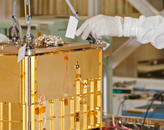 One of SAM's abilities is detecting and characterizing organic molecules—the type of chemicals used by life. Organic molecules are made of carbon and hydrogen atoms, so they are often called "hydrocarbons" even though they can also include other elements: frequently oxygen, nitrogen, sulfur, phosphorus, calcium, and iron. These atoms can join together in a huge variety of ways— usually in long chains or rings—so millions of organic molecules are possible. SAM will investigate whether any organics are present
in a selected area of Mars and, if so, what organics. The results could help us learn if a life-friendly neighborhood, or habitable environment, has ever been present there.
One of SAM's abilities is detecting and characterizing organic molecules—the type of chemicals used by life. Organic molecules are made of carbon and hydrogen atoms, so they are often called "hydrocarbons" even though they can also include other elements: frequently oxygen, nitrogen, sulfur, phosphorus, calcium, and iron. These atoms can join together in a huge variety of ways— usually in long chains or rings—so millions of organic molecules are possible. SAM will investigate whether any organics are present
in a selected area of Mars and, if so, what organics. The results could help us learn if a life-friendly neighborhood, or habitable environment, has ever been present there.
+ The Search [Click to Expand]
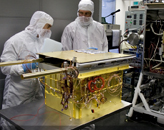
THE SEARCH FOR HABITABILITY AND PRESERVED SIGNS OF LIFE
Although life is mostly made of and uses organic chemicals, not all organic molecules are produced by life. For example, methane has been observed on Mars, and it can be produced both by living things as well as by geological processes. Scientists have detected a simple sugar molecule in interstellar gas and numerous amino acids in meteorites. But even though amino acids are the building blocks of proteins—an important class of chemicals used by life—many types of amino acids are synthesized randomly in chemical reactions in space. Life on Earth uses only a specific subset of amino acids.If SAM is fortunate enough to find organic chemicals in ancient Mars rocks, the next question will be how they got there. Were they produced on Mars, perhaps in an ancient lake? Or were they delivered from space by a meteorite? One clue to the source of these molecules will come from the stable isotopes of several key chemical elements.
Isotopes are versions of an element that are a little bit heavier because their nucleus contains more neutrons. For example, carbon-13 is an atom of carbon with an extra neutron, so it is a heavier version of the more common carbon-12. Occasionally, a carbon-13 will take the place of a carbon-12 in an organic molecule. This is important since life tends to use favor the lighter isotopes, because their chemical reactions with them require less energy. So, if we measure the isotopes of carbon in a material and discover that there is more light carbon relative to heavy carbon than would be found randomly, this might support an inference that we are seeing the effects of life; although however, it can also be a clue to created by other abiogenic non-living processes. If organic compounds are present, SAM will bake rocks and soils, releasing carbon gas.
SAM will also look for clues about the past habitability of Mars by looking for characteristic minerals of life-supportive environments, such as carbonates or sulfates. If SAM discovers these minerals in a specific area on Mars, it could mean that an aqueous environment, such as a spring, lake, or groundwater reservoir once existed there. If organics are found as well, perhaps this environment supported Martian life at one time.
+ THE SAM AND MARS SCIENCE LABORATORY PARTNERSHIP [Click to Expand]
Uncovering Clues
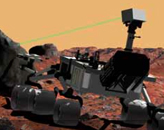 SAM will be tucked inside the protective interior of the Curiosity rover. To fit its ride, SAM has to be slim and trim. The team took equipment that normally fills an entire chemistry lab and shrank it down to fit in the space of a typical microwave oven.
SAM will be tucked inside the protective interior of the Curiosity rover. To fit its ride, SAM has to be slim and trim. The team took equipment that normally fills an entire chemistry lab and shrank it down to fit in the space of a typical microwave oven.
SAM is designed to analyze at least 74 samples over its core mission of two Earth years (one Mars year). To get the most science from the limited supply of samples, the SAM team will work closely with other instruments on MSL to identify the most interesting rocks or soil to analyze. The Curiosity boasts admirable roving power with wonderful ground clearance combined with powerful science tools. A stereo camera on a mast (Mastcam) will first locate outcrops or rocks of interest. A neutron detector called DAN (Dynamic Albedo of Neutrons) will scan samples searching for hydrogen. SAM can then further analyze samples thought to contain hydrogen, which are of interest because hydrogen is a key component of water and organic molecules.
The ChemCam (Chemistry and Camera) instrument can zap nearby rock (or soil) with a laser, creating a glowing gas called plasma. The camera will analyze light from the plasma to see what the rock is made of. If the rock is interesting, the Curiosity will zoom in for a closer look. A close-up camera (Mars Hand Lens Imager) and an element-identifying contact tool (Alpha Particle X-ray Spectrometer) will be used to get even more chemical information about the sample. Then SAM will spring into action, and all of this contextual information will help refine interpretations of SAM data.
+ SAM's GADGETS AND INVESTIGATIVE PROCEDURE [Click to Expand]
STEP 1: Prepare the sample
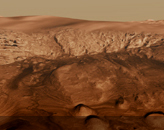 The MSL drill will pulverize a rock and deliver small samples of powder to both SAM and the CheMin (Chemistry and Mineralogy) instrument for detailed analysis of minerals and volatiles (things that vaporize easily, like water and gases).
The MSL drill will pulverize a rock and deliver small samples of powder to both SAM and the CheMin (Chemistry and Mineralogy) instrument for detailed analysis of minerals and volatiles (things that vaporize easily, like water and gases).
The Sample Manipulation System (SMS) transports powder delivered from the MSL drill to the SAM inlet and into one of 74 sample cups. The SMS then moves the sample to the SAM oven to release gases by heating it to about 1,000 degrees Celsius (1,832 degrees Fahrenheit). The oven is part of the Chemical Separation and Processing Lab (CSPL), which includes a lot of plumbing to enrich and process gases so they can be measured and characterized.
The ChemCam (Chemistry and Camera) instrument can zap nearby rock (or soil) with a laser, creating a glowing gas called plasma. The camera will analyze light from the plasma to see what the rock is made of. If the rock is interesting, the Curiosity will zoom in for a closer look. A close-up camera (Mars Hand Lens Imager) and an element-identifying contact tool (Alpha Particle X-ray Spectrometer) will be used to get even more chemical information about the sample. Then SAM will spring into action, and all of this contextual information will help refine interpretations of SAM data.
STEP 2: Separate the molecules
SAM consists of three instruments. Gas from the sample first travels to the Gas Chromatograph (GC) instrument. The purpose of this instrument is to sort out all the different molecules in the sample, and determine how much there is of each gas. It accomplishes this by using a stream of helium gas to push the sample down a long, narrow tube (which is wound into a coil to save space). Helium is used because it is inert, meaning it won't react with and change any of the sample molecules. The inside of the tube is coated with a thin film. As molecules travel through the tube, they stick for a bit on the film—the heavier the molecule, the longer it sticks. Thus, the lighter molecules emerge from the tube first, followed by the middleweight molecules, with the heaviest molecules bringing up the rear.
STEP 3: Identify the molecules
Since molecules of different weights emerge from the tube of the gas chromatograph at different times, the GC can send groups of different weights, one at a time, to SAM's detection instrument, which will determine exactly what kind of molecule makes up each of the groups. This is the Quadrupole Mass Spectrometer (QMS) instrument. It fires high-speed electrons at the molecules breaking them up into fragments and giving the molecules and their fragments an electric charge. These electrically charged molecules and their fragments can be moved by electric fields. The QMS uses both DC and AC fields to sort the electrically charged molecules and fragments based on their weight (mass). Molecules and fragments of different mass are counted by a detector at different times to generate a mass spectrum, which is a pattern that uniquely identifies molecules.
STEP 4: Identify the volatiles and determine the isotopes
After the QMS identifies the molecules, the sample is directed into the Tunable Laser Spectrometer (TLS), which can identify and analyze certain volatile molecules, such as water and carbon dioxide.
The sample enters a chamber with precisely positioned mirrors at both ends. A laser is fired through a tiny hole in one of the mirrors. As the laser light bounces between the mirrors, it illuminates the sample. Different molecules will absorb certain wavelengths (frequencies) of light, so the TLS identifies the molecules by which frequencies are blocked (since the laser is tunable, it can be adjusted to shine in a range of wavelengths). The TLS can also identify isotopes the same way. Since volatile molecules are found in the atmosphere as well as in soil and rock, samples of the Martian air can be sent directly to the TLS without going through SAM's other instruments. Researchers plan to use this capability to check for traces of methane in the air. Methane gas is the only organic chemical that has already been observed on Mars, so it will be important to make surface-based observations on Mars to help learn about the gas creation process.
+ WHO PREPPED SAM FOR THIS MISSION? [Click to Expand]
- Science team: Principal Investigator (PI), Paul Mahaffy/NASA Goddard Space Flight Center with 51 Co-Investigators and Collaborators from 28 institutions.
- Development team: Based at NASA's Goddard Space Flight Center, Greenbelt, Md., but with significant elements provided by industry, university, and NASA partners.
- NASA GSFC: Quadrupole Mass Spectrometer, CSPL, software.
- University of Paris/CNRS: Gas Chromatograph (Michel Cabane, Institutional PI).
- NASA Jet Propulsion Laboratory, Pasadena, CA: Tunable Laser Spectrometer (Chris Webster, Institutional PI).
- Honeybee Robotics, New York: Sample Manipulation System (Steve Gorevan Lead).
- SAM and MSL are funded by NASA's Science Mission Directorate.

